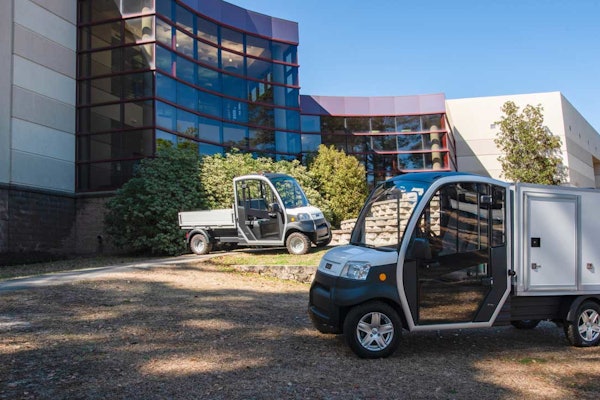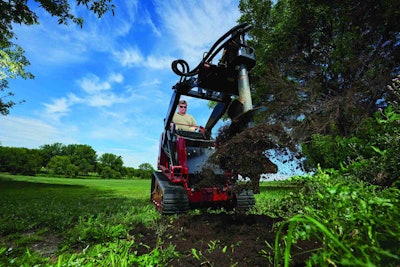 Photo: Toro
Photo: ToroCall them what you want – mini skid steers, mini track loaders, compact tool carriers – compact utility loaders (CULs) have lots of names, but the benefits are all the same.
CULs are popular for being able to get into tight spaces that even a skid steer might not be small enough for, hence the name mini skid steers, but some manufacturers are starting to come out with models that aren’t so ‘mini’ anymore.
One particular example is Toro’s TXL 2000 model that is positioned to be the largest compact utility loader yet. This addition is set to be available in late 2018 or early 2019.
Toro introduced the equipment class in North America 20 years ago and has the broadest range of CULs on the market with eight models. Contractors can choose between stand-on and walk-behind configurations, tracked and wheeled options, and a range of rated operating capacities to make it easier to find the right size machine for any landscaping application.
So as the rated operating capacity of CULs are either meeting or exceeding the rated operating capacities of entry-level skid steers, it raises the question, how should landscapers choose one machine over the other?
Purpose
Obviously, both of the machines are good for improving efficiency on the jobsite but depending on the task at hand will help you choose which one is better suited for your project.
Skid steers can be used for complete landscape installations, from preparing the rough grade to seeding a lawn and can also be good for irrigation installations or digging holes for new trees or fenceposts, according to Jason Boerger, marketing manager for Bobcat.
 Photo: JCB
Photo: JCBThese machines are also well-suited for moving a number of materials including soil, sand, trees, or pavers on large-scale jobsites.
“Wheeled machines are also commonly seen around nursery and landscape material lots, loading and unloading the material for customers,” said Randy Tinley, skid steer loader and compact track loader product manager with JCB. “Large mulch yards also benefit from the additional speed of a skid steer loader, compared to a track machine, and the smaller frame size which allows them to access mulch or rock storage bins, which makes skid steers ideal for landscape material yards.”
Meanwhile, CULs, as mentioned before, are ideal for accessing small spaces and Tinely says they are often rented for one-off, small landscaping projects like irrigation installation or small-scale retention wall work.
“These machines also do a good job of reducing the need for wheelbarrows and shovels because they can travel through tight spaces,” Boerger said. “Bringing sand or soil in for a project is much easier using a bucket on a mini track loader versus using a wheelbarrow and shovel to transport material.”
The CULs also benefit landscapers who need better visibility or need to mount and dismount the machine quickly and easily.
Factors to consider
Size and safety
One of the main differences between the pieces of equipment is, of course, their size.
The majority of CULs boast the ability to fit through a 36-inch gate, which is extremely beneficial for those landscape contractors mainly serving residential clients and as yard sizes shrink. This smaller size also enables these machines to be nimbler and typically a less expensive machine.
The lower operating weight CULs also helps with transportability to jobsites.
While CULs historically have been relegated to small- to mid-scale landscaping projects due to skid steers’ ability to lift more, that rule of thumb no longer applies with the newer models available.
 Photo: Ditch Witch
Photo: Ditch Witch“Mini skid steers are ideal for any sized landscaping job, thanks to their power and a full range of attachments, like trenchers and stump grinders,” said Chris Thompson, Ditch Witch product manager compact equipment. “In fact, the latest models, like the Ditch Witch SK1550, have enough power and versatility to be useful on jobsites where you’d traditionally use a full-sized skid steer machine.”
According to Kyle Cartwright, associate marketing manager for Toro, unless it’s a major landscaping overhaul or an expansive jobsite with multiple tons of material to be moved, there’s no reason why a landscape contractor wouldn’t want to choose a CUL.
“Models like the Toro Dingo TX 1000 can accomplish almost everything an entry-level skid steer loader can, while still realizing the inherent benefits of the compact utility loader equipment class – like excellent maneuverability and visibility as well as being able to hop on and off the machine quickly and easily,” Cartwright said.
Yet that ability to hop off and on the machine does leave the operator vulnerable, according to Tinley, who notes CULs are less stable machines that offer little, if any, roll-over or impact protection for the user.
“With compact utility loaders having significant disadvantages in terms of safety, lower rated operating capacity and limited attachment versatility, we consider compact utility loaders to be a specialized machine with limited applicability for commercial use,” Tinley said.
Power
When it comes to specs, horsepower is an easy one to assume that higher horsepower equipment will naturally perform better, but Boerger advises taking the amount of torque the machine has into account as well.
“You want to try and match the machine, its capabilities and its physical size to the what it will be doing on the jobsite,” Boerger said. “While horsepower is an important spec to look at, it is one of many specs a landscaper will need to consider.”
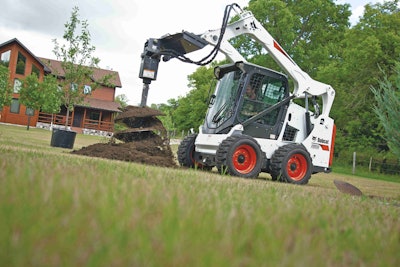 Photo: Bobcat
Photo: BobcatWhile higher horsepower is important to consider when running a high-flow attachment, it may not be as significant as machine weight or maneuverability in certain settings.
“Over the years, advancements in technology have increased performance of the skid steer and compact utility loader equipment classes, without hinging entirely on horsepower,” Cartwright said.
When looking at the overall performance of a skid steer or a CUL, contractors need to consider the hydraulic system pressure, flow and the overall machine design, Cartwright says.
“As the amount of power available has increased with newer designs, the attachments made for mini skid steers have also evolved,” Thompson said. “Landscapers can replace multiple larger machines with a single mini skid steer using numerous attachments.”
Wheels versus tracks
It is a common decision factor when having to choose between a skid steer and a compact track loader (CTL) to evaluate whether wheels or tracks are better, but landscapers do not necessarily have to choose a skid steer if they want wheels, as Toro does offer wheeled versions of the Dingo.
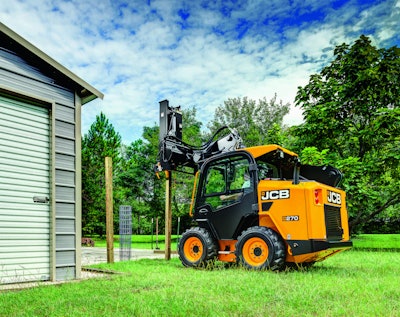 Photo: JCB
Photo: JCBSkid steers are suited for jobsites with sharp bumps or rocky conditions and can cover distances quickly over hard surfaces with its wheels while CULs tend to be more turf-friendly and Cartwright says landscapers can enjoy all the benefits of tracks without having to upgrade to a more expensive CTL.
“Those machines (CULs) also work well in soft, wet and sandy ground conditions because of better floatation the tracks provide,” Boerger said. “This flotation is especially helpful if a landscaper is working in early spring or late fall when it tends to be wetter in many areas, especially in the Midwest.
Making a decision
The main argument skid steers had in their favor in the past was having a higher rated operating capacity, and as this line blurs between the two equipment classes landscapers have to ask different questions to find the right fit for them.
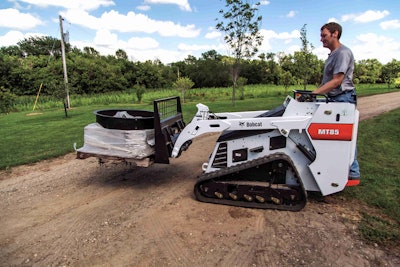 Photo: Bobcat
Photo: Bobcat“Contractors will want to consider whether a more compact, more maneuverable piece of equipment is important to them or not,” Cartwright said. “With a higher power-to-weight ratio in the compact utility loader class, contractors are able to deliver the same power in a smaller package.”
Cartwright says ultimately decision hinges on the needs of the specific operation, but in most cases, the right compact utility loader can take the place of many skid steer models without sacrificing power.
“There are additional tangible cost factors to consider, like capital investment costs, transport and warehousing costs, and maintenance costs – all historically lower for compact utility loaders when compared to skid steer loaders,” Cartwright added.
Other factors JCB highlights as major considerations are jobsite location and requirements, attachment operation, and speed of completing the job.
“The fact still remains that you need to match the machine to the work that is going to be done,” Boerger said. “Skid steer loaders still have much higher rated operating capacities than even the largest of the mini track loaders. Factors like rated operating capacity, fuel consumption, required tasks and auxiliary hydraulic flow needs are just a few things that landscapers have to consider when looking at which machine will be best for their business.”
More coming to market
According to Ditch Witch, the mini skid steer market is strong and continuing to grow, with manufacturers releasing larger additions like the SK1550 and the TXL 2000.
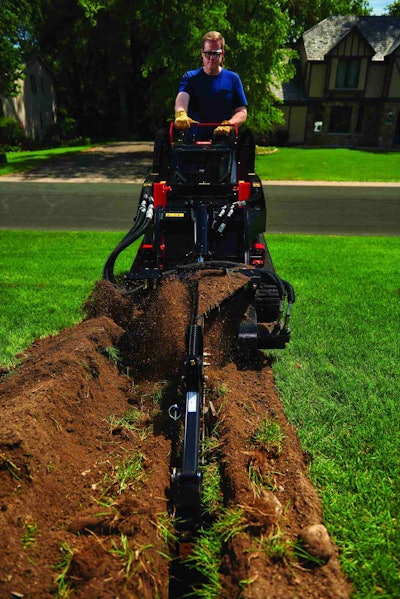 Photo: Toro
Photo: Toro“Landscapers recognize the versatility and capabilities of these machines and understand they’ll continue to change with their needs,” Thompson said.
However, it remains to be seen if other brands will try to break into this market. JCB is skeptical and sees the machine suited for more niche jobs.
“The compact utility loader is the better choice only for light work on small job sites,” Tinley said. “The compact utility loader is at a definite disadvantage when it comes to rated operating capacity and stability. Additionally, compact utility loaders typically feature lower hydraulic flow which limits the operations of attachments, and therefore machine versatility.”
Toro has more of a wait and see attitude towards the addition of more CUL manufacturers.
“Historically speaking, manufacturers – including Toro – tend to go bigger when looking to expand their proven product lines into other equipment classes, not smaller,” Cartwright said. “It remains to be seen whether popular skid steer manufacturers will break into the compact utility loader class.”




